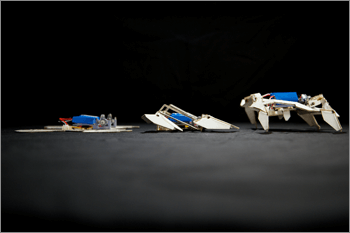A new development demonstrates the potential for sophisticated machines that build themselves

A team of engineers used the classic children's toy dinks Shrinky - which shrinks when heated - to build a robot that assembles itself from a flat state into a complex shape in four minutes, and crawls away without any human intervention. The new development demonstrates the potential to quickly and cheaply build sophisticated machines that interact with the environment, and also to save a large part of the design and assembly process.
The method draws its inspiration from self-assembly in nature, as it occurs for example in the linear sequences of amino acids that fold by themselves into complex proteins with sophisticated functions.
"The possibility for a robot to be able to assemble itself independently and perform the task assigned to it has been a milestone that we have been chasing for many years," says Dr. Rob Wood, a faculty member at the Wyss Institute for Biologically Inspired Engineering at Harvard University and the Charles River Professor of Applied Engineering Sciences. at the Harvard School of Applied Engineering Sciences (SEAS). The team included engineers and computer scientists from Harvard's Wyss and SEAS Institutes and the Massachusetts Institute of Technology (MIT).
In addition to expanding the possible ways of manufacturing robots in general, the method will be able to be used for more exotic applications.
"Imagine dozens of robotic satellites crammed together so they can be sent up into space and then remotely assemble themselves once they get there. They can take pictures, collect data, and continue their mission as if they had already been launched, said Sam Felton, a PhD student at SEAS and lead author of the paper.
The robots are the culmination of a series of improvements made by the team in recent years, including the development of printed robotic components that still require human involvement during the folding itself - and the self-folding lamp that had to be operated by a human after assembling itself. The new robot is the first to build itself and function without human intervention.
"We have created here a complete electro-mechanical system embedded into one flat two-dimensional form," said Felton. Team members used computerized design tools to get the optimal design and folding pattern—and after about 40 prototypes, Pelton found the robot that could fold itself and walk away. He created the XNUMXD shape using a solid ink printer, a laser machine, and his hands.
The exquisite design took just two hours to assemble using a method that relies on origami, the ancient Japanese art of folding a single sheet of paper into complex structures. The origami-inspired approach allowed the team to avoid the need to use "bolts and nuts" which is the traditional approach to assembling complex machines.
They started with a flat sheet, to which they added two motors, two batteries, and a tiny controller (micro controller) - which acts like the "brain" of the robot, Felton said.
The sheet consisted of paper and Shrinky Dinks, a toy containing Styrofoam - and one flexible circle in the middle. The robot also included hinges that were programmed to fold at certain angles. Each shaft contained embedded circuits that produced heat on command from the tiny controller. The heat causes self-folding in a series of steps.
When the hinges have cooled down after about four minutes, the styrofoam hardens - making the robot rigid. The tiny controller signals the robot to crawl and move away at a speed of about a tenth of an hour. The whole event consumes the amount of energy stored in one AA alkaline battery.
The current robot runs on a timer, waits about ten seconds after the batteries are installed and starts folding. However, "we can easily change this so that the folding is triggered by a sensor for an environmental factor, such as temperature or pressure," Felton said.
One of the main challenges in the process, according to Felton, was the robots' tendency to burn out before they were properly folded. "There are many ways we can improve this foundational step," said Felton, who plans to experiment with different types of shape-memory polymers — materials like Styrofoam but stronger and requiring less heat to operate.
The method is a complementary method to XNUMXD printing, which holds great promise for the fast and cheap production of robotic components but also has difficulty integrating the electrical components and in this specific case, it would have taken longer to produce the functional prototype.
The long-term dream, according to Wood, is to build a device that anyone can assemble at home when a home robot is needed for assistance. "You'll be able to describe what you need in basic terms, come back an hour later and get your robotic assistant," Wood said. In total, each robot costs about $100, but only $20 for the body without motors, batteries, and tiny controllers.
Source: Wise Institute for Biology-Inspired Engineering at Harvard University
